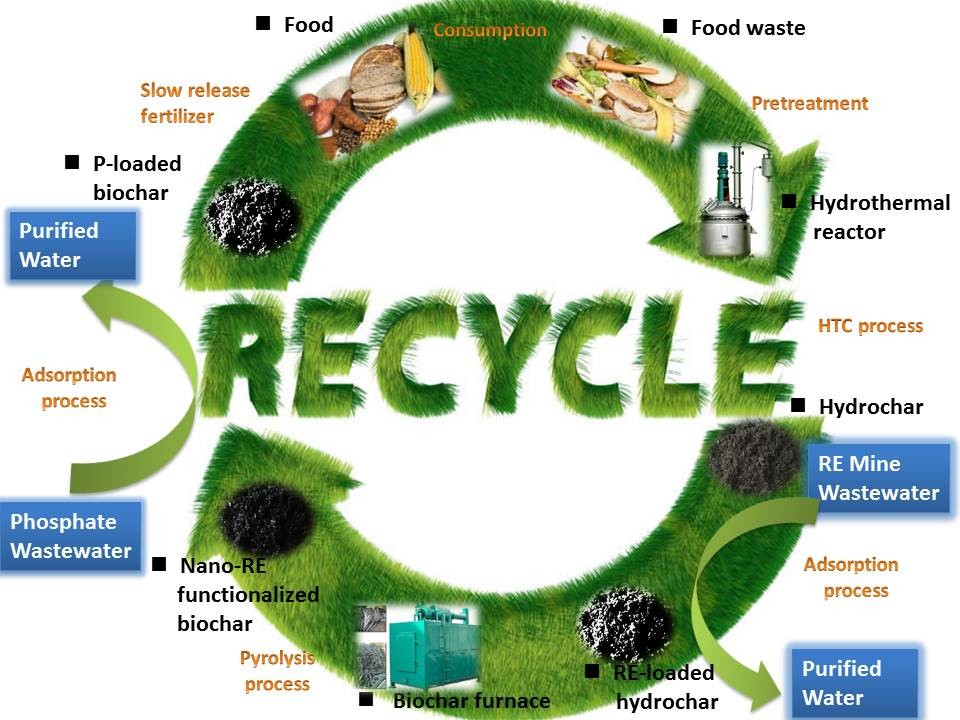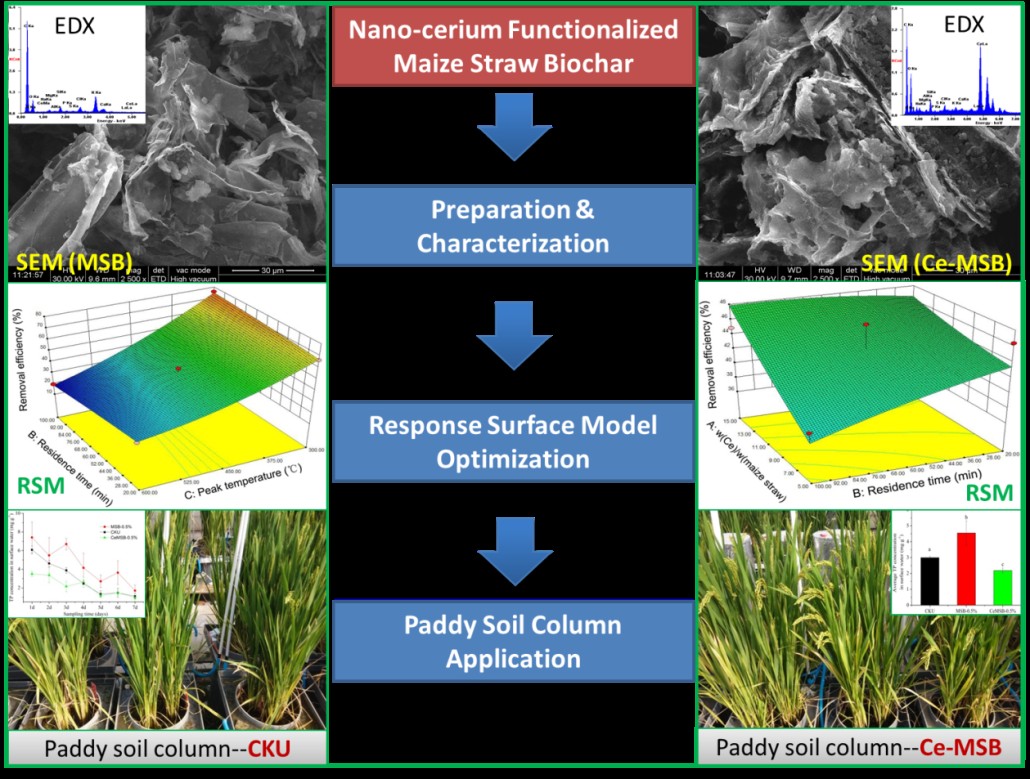1) Fabrication of hydrochar based on food waste (FWHTC) and its application in aqueous solution rare earth ions adsorptive removal: Process, mechanisms and disposal methodology
Hydrothermal carbonization (HTC) of food waste is a promising technology to dispose these widely generated and notorious wastes. Food waste hydrochar (FWHTC) was produced during this process. However, production and application of FWHTC remained at embryo stage. Herein, this study for the first time produced leftover steamed bread hydrochar (LSHTC) and pitaya peel hydrochar (PPHTC), and then applied them to adsorptive remove rare earth ions (REI) from wastewater. FWHTCs were systematically characterized by SEM, FTIR, XPS, BET, elemental analysis and TG-DSC. Isotherm study showed that Langmuir model fitted the data well at lower initial REI concentrations while Freundlich model fitted better at higher concentrations. The maximum adsorption capacity of LSHTC for La3+ reached 108 mg g−1. Continuous adsorption experiment in adsorption column was also conducted and key operation parameters were predicted by Yoon-Nelson model. The adsorption mechanisms were dominated by physisorption (electrostatic attraction) at the very starting stage, followed by chemisorption (ion exchange and/or surface complexation) playing a key role. At last, a sustainable “Reduce-Reuse-Recycle” pattern of food waste disposal methodology was proposed.

2) Nano-cerium oxide functionalized biochar for phosphate retention: preparation, optimization and rice paddy application
In this study, nano-cerium oxide functionalized maize straw biochar (Ce-MSB) was prepared and utilized to remove P from agricultural wastewater. Response Surface Model was applied to optimize the operating conditions. Moreover, Ce-MSB was applied to actual rice paddy column for the first time. Response Surface Model (RSM) showed higher materials ratio had positive effect on PO43− adsorption capacity, while higher pyrolysistemperature had negative effect. The maximum adsorption capacity of Ce-MSB for PO43− was 78 mg g−1, implying that Ce-MSB was an effective functionalized adsorbent for P removal. Paddy soil column experiment showed that application of Ce-MSB decreased total phosphorus concentration of surface water by 27.33% and increased total phosphors (TP) content of top soil by 7.22%. Further, Ce-MSB tends to increase rice plant height and leaf area. Therefore, Ce-MSB can be used as a promising functionalized biochar to reduce the risk of phosphorus loss from paddy field surface running water.

3) Cerium-modified biochar: A recycling biomaterial for regulating phosphorus availability in paddy ecosystem from coastal mudflat reclamation
Phosphorus (P) is a vital element for plant growth, especially in mudflat-reclaimed soil due to its extra alleviation of adverse effect by salt stress. P availability in mudflat-reclaimed soil is a critical factor for crop yield. In this study, cerium-modified straw biochar (Ce-MSB) derived from maize straw was prepared and characterized and its influence on P availability of the paddy soil was evaluated. The results indicated that the cerium elements were chemically bound to the functional groups of the biochar surface through SEM, EDX and FTIR techniques. The equilibrium process of P by Ce-MSB was described well by the Langmuir isotherm model (R2 > 0.99). The maximal P adsorption capacity of Ce-MSB was influenced remarkably by temperature. Accordingly, the addition of Ce-MSB significantly decreased the P content of surface water in paddy system after 3 months, while increasing the soil P availability. Furthermore, the incorporation of both common biochar and Ce-MSB into the soil increased the SOM content, while decreased soil pH and EC. Biolog EcoPlateTM trials indicated that Ce-MSB has no significantly negative effects on soil microbial diversity. This study provides valuable information for the source-reduction of P discharge from paddy system and improvement of P availability. Phosphorus (P) is a vital element for plant growth, especially in coastal reclaimed mudflat due to its extra alleviation of adverse effect by salt stress. P availability in mudflat-reclaimed soil is a critical factor for crop yield. In this study, cerium-modified straw biochar (Ce-MSB) derived from maize straw was prepared and characterized and its influence on P availability of the paddy soil was evaluated. The results indicated that the cerium elements were chemically bound to the functional groups of the biochar surface through scanning electron microscopy (SEM), energy dispersive X-ray spectrum scanning (EDX), and fourier transform infrared spectroscopy (FTIR) techniques. The equilibrium process of P (PO43−) by Ce-MSB was described well by the Langmuir isotherm model (R2 > 0.99). The maximal P adsorption capacity of Ce-MSB was influenced remarkably by temperature, which was 58, 69, and 78 mg g−1 under 5, 25, and 40 °C, respectively. Under laboratory simulation, the addition of Ce-MSB significantly decreased the P content of surface water in paddy system after 3 months, while increasing the P availability of soil. Furthermore, the incorporation of both common biochar and Ce-MSB into the soil increased the SOM content, while decreased soil pH and EC. Biolog EcoPlateTM trials indicated that Ce-MSB has no significantly negative effects on soil microbial diversity. This study provides valuable information for the source-reduction of P discharge from paddy system and improvement of P availability.
References:
1. Feng, Y.F., Sun, H., Han, L., Xue, L.*, et al. 2019. Journal of Cleaner Production, 212, 1423-1433.
2. Lu, H., Feng, Y.F.*, Feng, Y.Y, Dong, Y., et al. 2019. Geoderma, 346, 43-51.
3. Feng, Y.F., Lu, H., Liu, Y., Xue, L., et al. 2017. Chemosphere, 185, 816-825.


